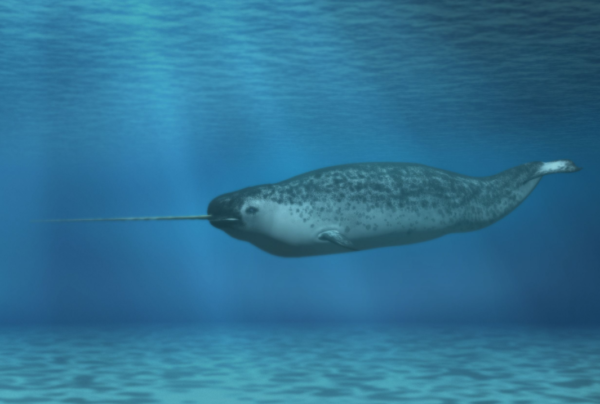Whether a thousand years ago or today in the 21st century, Narwhals evoke mystery. These creatures of the sea are thought to have sparked the mythology surrounding unicorns, as they are the closest living animal resembling the mystical and magical creature.
Narwhals have inspired awe throughout the ages. Inuit legends hold an origin story for the animal, claiming that a woman who wore a long plait was thrown into the ocean by her son after a dispute and transformed into what we now know as the narwhal. During the age of Viking domination in Northern Europe, their tusks sold for ten times their weight in gold. Medieval merchants sold the tusks to members of royal families and claimed that it was the horn of a unicorn – they believed that the unicorn horn could detect poison, increase virility, cure the plague, and even raise the dead! Queen Elizabeth I was gifted a tusk during her reign that was encased in jewels and was worth the same amount as a castle. Today, this would be approximately $3 million. The mythology of the narwhal can be found within literature too; an excerpt from Herman Melville’s ‘Moby Dick’ discusses how Danish kings throughout the ages sat in thrones made from their tusks.

Mythology aside, the narwhal is a medium–sized whale from the same family as the beluga whale. The largest males can weigh in at a total of two tons and grow up to 16 feet long. They frequent the icy waters of the Arctic Ocean and can occasionally be seen off the coasts of Greenland, Canada and Russia. The ice on the surface of the water protects them from predators such as polar bears, and in the deep ocean below, there are plentiful resources of flatfish cod and halibut for them to feast upon.
Of course, the narwhal isn’t in fact a relation of the unicorn. Furthermore, what is commonly mistaken for a horn on the narwhal’s head is actually an upper left canine tooth protruding from its mouth. These are similar to the tusks that you can witness on a walrus or an elephant.
The narwhal is a unique feature of the animal kingdom; it is the only animal that sports a straight tusk, which in some examples can grow up to 10m in length! What makes the tusk even more curious is that it grows in a spiral and can bend significantly without breaking. Researchers and academics are still stumped over what the narwhal’s tusk is actually used for. When kept in captivity, narwhals die very quickly, so the only observation that can be practised is within the wild, and even then, they are very shy characters.
The tusk is covered in nerve endings, essentially like an inside-out tooth. They are not used to kill their prey or to fight, though narwhals have been known to occasionally cross swords. The length of the tusk is more prominent in males, so it is believed that they have the same function as antlers do for deer – the bigger the tusk, the more alpha the narwhal.
There is still much research to be done on the narwhal. One theory regarding the tusk is that it is used to detect changes in the surrounding ocean, such as the saltiness or temperature of the water. Another theory is that the tusk is a sonar device used to explore the dark depths of the ocean, but this hasn’t been academically confirmed.
There are many wild and wonderous animals that populate the earth, but the narwhal is certainly one of the most mysterious, steeped in myth and legend. These timid whales have amazed people throughout the ages and certainly deserve our respect and admiration.







